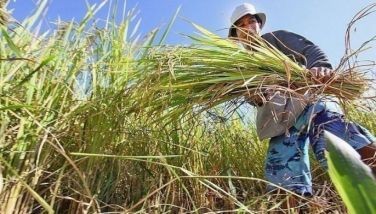Uniquely Batanes: Arius food products
MANILA, Philippines - When one talks about Batanes, one will probably blabber about the endless rolling hills, the majestic view of the Pacific Ocean, the rustic Ivatan traditional house, the lofty lighthouses, the heartwarming Ivatans, among others.
One would perhaps miss out on mentioning those pine-like trees that gloriously stand out along the sidelines and provide a decorative landscape on the roads and landmarks of Batanes.
Given their abundance, particularly when traversing the streets of Basco, Mahatao, Ivana or even in the islands of Sabtang and Itbayat – this tree will awe any tourist on how the Ivantans make use of them.
The tree, known as Arius (Podocarpus costalis), is an endemic in Batanes. It serves as an excellent ornamental tree often used by the Ivatans as a Christmas tree during the Yuletide season.
Arius bears fruits during the months of July to October. Its berries are edible and its appearance and taste compare to that of duhat. The Arius berry is fleshy and turns from red to purple when mature. The taste is mildly sweet and tangy. The berry has a single green seed attached to it, just like the cashew. Its seed is found at the end of the fruit.
Not just for decoration
“It is regrettable that the Ivatans are not aware that these fruits can be processed into valuable products” said Dr. Edwin F. Macaballug, president of the Batanes State College (BSC).
This observation was reaffirmed by the faculty of BSC who also shared that the Ivatans would just usually let the Arius berries fall and rot from the tree or be eaten by the birds.
“I told them that in the mainland (general term for Luzon) Arius is only used as ornamental plant because it would not bear berries outside Batanes,” Macaballug said.
The potential of Arius berries to turn into processed food products only started in 2012 when the director for research and extension of BSC, the late Dr. Roger G. Baltazar, took interest on Arius berries. His interest in the berries prodded him to submit a proposal to the Bureau of Agricultural Research (BAR) which was then funded under the BAR’s National Technology Commercialization Program (NTCP).
Making Arius known across the country as commodity that is uniquely Batanes is starting to take shape.
Developing food products
Upon the approval of project, the first product that BSC developed was the Arius wine. Fruit-based wines are considered a healthy beverage, if taken in moderation.
Red wine, such as those from Arius, helps fight heart diseases. The berries are high in flavonoids which function as antioxidants in human.
With fruit-based wines progressively carving their niche in the beverage market, the BSC has joined numerous product trade fairs and exhibits to market test Arius products – especially the wine. Based on the results, Arius wine passed the standards of a fruit-based wine.
Satisfied with the quality of Arius wine, the project team then focused on the improvement of its packaging. They have tapped the weavers of Batanes to make the special wine holder which is made out of the same material used in making vakul (Ivatan traditional headgear).
“We paid the elderly weavers P100 for every wine holder. It is especially designed for the Arius wines. It is our way of helping them in getting income and promoting the handicrafts of Batanes,” said Djovi R. Durante, study leader of the project.
Other Arius-based products developed include pastillas, tart, jam, jelly, and tea.
The project team has foreseen that the demand for the Arius wine and other Arius-based products will boom once it has been commercialized in the whole province and most likely, the products will also appeal among the tourists who are looking for souvenir gifts.
The BSC is drawing up strategies on how to expand their production and widen their market reach. However, they are having problems with the availability of the Arius berries because of its seasonality.
The influx of tourists visiting the island starts from November to June, which is the lean season for the Arius berries. They have came up with a solution to acquire additional cold storage equipment to store the Arius berries so that even if it is off-season, they can still produce the products.
They BSC will also start on the technology transfer of Arius processing to the Ivatan housewives to help them in supplying the Arius products.
“Due to word-of-mouth, the tourists came to us to buy Arius products, especially the wine, which surprised us because we are not yet promoting it heavily to the public. There are also travel agencies who were vocal in their intentions of becoming an exclusive distributor,” shared Durante.
The project team plans to organize an Arius tree planting activity. Durante mentioned that with the recent developments in Batanes – such as the road widening, many Arius trees are being cut down.
A newly-planted Arius tree usually takes 10 to 15 years before it bears fruit. With this initiative on tree planting, there is an assurance that there will be Arius trees available for future Ivatans.
Due to the uniqueness of the commodity, the Arius wine was given a citation award as “Best New Product” during the BAR-organized event, the 9th National Agriculture and Fisheries Technology Forum and Product Exhibition held at SM Megamall in 2013.
A year after heeding the recommendations for the further improvement of the product and its packaging, the Arius-based products bagged the grand prize for the “Best Packaged Product” and “Best Newly-Developed Product” during the North Luzon Cluster S&T Fair organized by the Department of Science and Technology (DOST).
- Latest

























